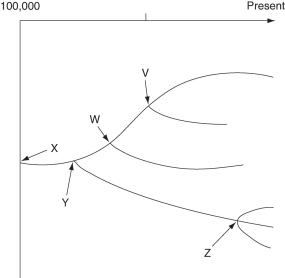Multiple Choice
The following questions refer to the evolutionary tree in Figure 22.2.
The tree's horizontal axis is a timeline that extends from 100,000 years ago to the present; the vertical axis represents nothing in particular. The labeled branch points on the tree (V-Z) represent various common ancestors. Let's say that only since 50,000 years ago has there been enough variation between the lineages depicted here to separate them into distinct species, and only the tips of the lineages on this tree represent distinct species.

-In a hypothetical environment, fishes called pike-cichlids are visual predators of algae-eating fish (i.e., they locate their prey by sight) . If a population of algae-eaters experiences predation pressure from pike-cichlids, which of the following should least likely be observed in the algae-eater population over the course of many generations?
A) Selection for drab coloration of the algae-eaters
B) Selection for nocturnal algae-eaters (active only at night)
C) Selection for larger female algae-eaters, bearing broods composed of more, and larger, young
D) Selection for algae-eaters that become sexually mature at smaller overall body sizes
E) Selection for algae-eaters that are faster swimmers
Correct Answer:

Verified
Correct Answer:
Verified
Q1: Which of the following pieces of evidence
Q1: Structures as different as human arms, bat
Q5: Which pair would have been likely to
Q6: Who would have proposed that the boundaries
Q7: If the HMS Beagle had completely bypassed
Q7: The following questions refer to the evolutionary
Q8: Which of these naturalists synthesized a concept
Q9: The following questions refer to the evolutionary
Q10: A biologist studied a population of squirrels
Q22: DDT was once considered a "silver bullet"